Chapter 8: Texture readings and exercises

Textures in the MET collection: https://www.metmuseum.org/connections/texture#/
Anselm Kiefer Khan Academy
Sketchbook:
Frottage:
Is a technique or process of taking a rubbing from an uneven surface to form the basis of a work of art. Take your sketchbook, some pastels and/or charcoal and wander about the classroom, building, and outside. Take as many rubbings as possible, make sure you label each texture surface and the location you found it on your paper. After you’ve collected at least 10 textures, select four to recreate. Try your best to draw the texture you’ve captured in your sketchbook. Check out Kent Bellows work, he masterfully uses texture to create environments and fill negative space.

Organic boxes:
Draw 9 cubes or spheres and use various organic textures with any media to enforce the illusion of 3 dimensionality. See examples below.


Smooth and Plastic:
Find two objects that are plastic. Map out the objects lightly in graphite, include highlights and shadows, or any unusual textures. Use color pencils or pastels and illustrate the smoothness of each item.
Origami:
Make an origami animal. Use graphite to draw the shapes and add value. The white of your drawing paper should be the highlights/brightest whites of the draw origami object.
Reading assignment:
Surrealism: What were the Surrealists about? Their content was confusing, fascinating, full of illusion…open for interpretation. Read about the movement and select few artists to study further. Pick at least three, be prepared to talk about them in class.
Rauschenberg: What type of photography and material did Robert Rauschenberg for his screenprints? How did he overlap and integrate various imagery to build content and visual stimulation?
Writing assignment:
Poetry: Write a sestina poem using words to describe an objects texture(s).
A sestina is a poem with six stanzas of six lines and a final triplet, all stanzas having the same six words at the line ends in six different sequences that follow a fixed pattern, and with all six words appearing in the three line conclusion.
Wikipedia explanation
Large projects:
Roy Lichtenstein was part of the American 1960s Pop Art movement. He used ben day dots seen in commercially printed items as the foundation to construct his satirical imagery. His work looks machine made but each piece is painted by hand.
Find a quote from a friend, family member, or meme to make a ben day dot image. The words/language in your art can be coming from a person or object. For this project you can use any color media, however, use primary colors to stick with the Lichtenstein concept.
MoMA Roy Lichtenstein
MoMa Pop Art Learning
From Op Art to Pop Art – TATE
Maya Codex:
The most famous codex is the Dresden Codex, with more than half of the content is astronomical information, cycles of planets and stars, eclipses, etc. The Mayans used the codex to plan the calendar year with ceremonies tied to star and planet movement. For them, Mars was represented by a long nosed deer while Venus was a star shape. What type if information is important to you? How could you document your week using shapes, forms, textures, patterns? Can you come up with a codex? – any media –

How to Make the Book: Ancient Book Lab – Making Your Own Codex
Therianthropic Self Portrait:
Draw yourself as half human and half animal. Therianthropes are shapeshifting mythical creatures or deities. Khepri is a scarab headed Egyptian god, Kurma is human tortoise, Kinnara is bird and human, Kumiho is half fox and half human. What animal are you and how will you integrate their physical characteristics into a self portrait? Use any dry drawing media for this project. Focus on textures to illustrate the human and animal aspects; hair/fur, skin, scales, hands/paws/wings…
Artists to research:
Anslem Kiefer
Andy Goldsworthy
Van Gogh
Gerhard Richter
Andrew Wyeth
How Andrew Wyeth Made a Painting
Dutch Still Life Paintings
Kent Bellows
Aboriginal Dreamtime
Jay DeFeo’s The Rose
Terry Winters
Eva Hesse
Kehinde Wiley
Ernst Haeckel
El Anatsui
Barbara Hepworth

